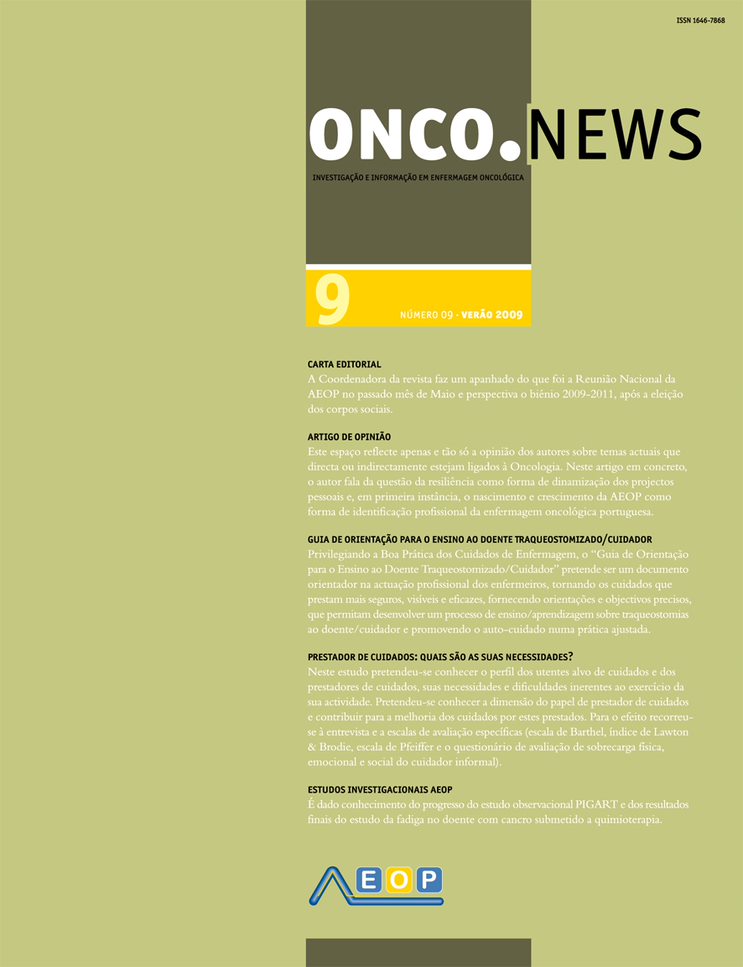Guidance for Teaching Tracheostomized Patients/Caregivers
DOI:
https://doi.org/10.31877/on.2009.09.01Keywords:
Tracheostomy, Tracheostomized Patients, Caregiver, Orientation Guide, Ostomy Ventilation, Teaching, AutonomyAbstract
Promoting the Practice of nursing care, the “Orientation Guide for the Teaching of Tracheostomized Patients/Caregivers will be a guiding document in the activities of professional nurses, making the care they provide safe, visible and effective, providing guidance and precise objectives, enabling them to develop a process of teaching/learning about tracheostomies for patients/caregivers, and promoting self-care in a practice set.
The Orientation Guide for the Teaching of Tracheostomized Patients/Caregivers may become an important tool of work for the professionals, whose objective is always the achievement of gains in health for the target customers of nursing interventions. A uniform standard of procedures, associated with the provision of personalized care, contributes to the excellence of care and the state-of-the-art.
Downloads
References
Albert, S.M. (1992) “Psichometric investigation of a belief system: caregiving to the chronically ill parent”. Social Science Medicine, 35: 699-709.
Albert, S.M., Brody, E.M. (1996) “When elder care is viewed as child care: significance of elder’s cognitive impairment and caregiver burden”. The American Journal of Geriatric Psychiatry, 4: 121-30.
Aoun, S., Kristjanson, L. (2003) “The social impact of caring for terminally ill people: Sustaining the well-being of carers in rural Australia” National Rural Health Conference.
Araújo, F., Ribeiro, J., Oliveira, A., Pinto, C. (2007) “Validação do índice de Barthel numa amostra de idosos não institucionalizados”. Revista Portuguesa de Saúde Pública, 25(2): 59-66.
Bliss, J. (2005) “What do informal carers need from district nursing services?” British Journal of Community Nursing, 11(6):251-54.
Bliss, J. (2005) “Working in partnership with adult informal carers”. British Journal of Community Nursing, 10(5): 233-5.
Christakis, N.A., Iwashyma, T.J. (2004) “The health impact of health care on families: a matched cohort study of hospice use by decedents and mortality outcomes in surviving, widowed spouses” Social Science Medicine, 57:465-75.
Classificação Internacional para a Prática de Enfermagem CIPE/ICNP (2000). Versão Beta. Lisboa: IGIF.
Ferreira, F.A. (1990) “Moderna Saúde Pública”, 6ª ed., Lisboa: Fundação Calouste Gulbenkian.
García-Calvente, M., Mateo-Rodríguez, I., Eguiguren, A.P. (2004) “El sistema informal de cuidados en clave de desigualdad”, Graceta Sanitária, 18 Suppl 1:132-9.
Imaginário, C. (2002) “O idoso no contexto dependente em contexto familiar”. Lisboa. Formasau.
Instituto Nacional de Estatística (2004) “Projecções de População Residente, Portugal e NUTS II, 2000-2050”, Instituto Nacional de Estatística, Lisboa.
Instituto Nacionale de Serviços Sociales (1995) “Cuidados en la vejez: el apoyo informal”. Madrid. Ministério de Assuntos Sociales.
Lawton, M.P., Kleban, M.H., Moss, M., Rovine, M., Glicksman, A. (1989) “Measuring caregiving appraisal. Journal of Gerontology”: Psychological Sciences, 44:61-71.
Martins, T., Ribeiro, J.P., Garrett, C. (2003) “Estudo de validação do questionário de avaliação da sobrecarga para cuidadores informais”. Psicologia, Saúde & Doenças, 4(1):131-48.
Moreira, I.M.P.B. (2001) “O doente terminal em contexto familiar”. Coimbra, Formasau – Formação e Saúde, Lda.
Rodriguez, B.E., Alvarez, E.D., Cartes, O.P. (2011) “Cuidadores Informales, Necessidades y Ayudas”. Revista Rol de Enfermeria, 24(3):183-9.
Rosa, M.J., Chitas, P. (2000) “Unidades e pluralidades da demografia portuguesa: perfis e dinâmicas concelhias, 1960-1961”. Lisboa. Instituto de Ciências Sociais da Universidade de Lisboa.
Swanson, K. (1991) “Desenvolvimento empírico de uma teoria do cuidar de médio alcance”. In: Nursing Research, 3:161-6.
Wright, L.M., Leahey, M. (2000) “Nurses and families – A guide to family assessment and intervention”. Philadelphia: Davis Company.
Downloads
Published
How to Cite
Issue
Section
License
Copyright (c) 2023 Carla Faria, Juliana Santos

This work is licensed under a Creative Commons Attribution-NonCommercial-ShareAlike 4.0 International License.




